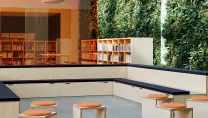The design of office interiors plays a crucial role in the well-being of employees, influencing their productivity, creativity, and overall satisfaction in the workplace.
A thoughtfully designed office space goes beyond aesthetics; it directly impacts the physical and mental health of individuals, fostering a positive and conducive environment for work.
In this blog, we will explore the various aspects of office interior design and its effect on the well-being of employees.
Fostering Collaboration
Interior office design significantly influences employee well-being by fostering collaboration through open-plan layouts and strategic meeting spaces.
Open-plan layouts are integral to fostering collaboration and promoting a sense of accessibility and transparency within the workplace. They also encourage communication and teamwork, breaking down physical barriers between colleagues. The absence of physical barriers encourages spontaneous conversations, idea-sharing, and a collective sense of purpose.
Dedicated meeting spaces equipped with modern technology facilitate seamless collaboration and offer a space for focused discussions and presentations. Complementing these formal meeting spaces, informal meeting areas/break-out areas provide employees with comfortable settings for impromptu conversations, brainstorming sessions, and relationship-building.
These office interior design elements not only enhance teamwork but also contribute to a sense of community, creating an inclusive and dynamic work environment that positively impacts the overall well-being of employees.
Biophilia
The incorporation of biophilia, or the integration of natural elements into office interior design, has a profound impact on employee well-being. Bringing elements of nature indoors, such as indoor plants, natural light, and views of greenery, has been shown to reduce stress, enhance mood, and boost overall mental health.
Conducting a comprehensive literature review, Kaitlyn Gillis and Birgitta Gatersleben from the University of Sussex, establish a connection between indoor plants and stress reduction. Their report emphasises the capacity of plants to introduce a vibrant, living element of nature directly into indoor spaces. They note that psychological studies consistently demonstrate the positive impact on health and well-being when indoor environments have plants, highlighting the therapeutic benefits of incorporating greenery into indoor settings.
Research carried out by Cornell's Department of Design and Environmental Analysis, shows that employees positioned within 10 feet of a window experienced an 84% reduction in symptoms related to eyestrain, headaches, and blurred vision.
By creating workspaces that emulate natural environments, organisations not only contribute to the physical health of their employees but also nurture a positive atmosphere that supports their overall well-being.
Integrating Technology
Integrating technology into the workplace streamlines processes, fosters communication, and provides tools for flexible work arrangements.
Advanced collaboration platforms such as Microsoft Teams and Slack, facilitate seamless communication, breaking down barriers and creating a more connected work environment. Additionally, technological solutions have the ability to automate repetitive tasks, reducing workload stress.
A report by the Office for National Statistics showed that more than three-quarters of those who worked from home since the COVID-19 pandemic said that being able to work from home gave them an improved work-life balance and almost half also reported improved well-being. Remote work options supported by technology contribute to a healthier work-life balance. Ergonomic tools and applications can address physical well-being concerns, ensuring comfortable and efficient workspaces.
Embracing technology not only boosts productivity but also empowers employees, offering them the tools and flexibility that contribute to a positive and supportive work experience.
Attracting and Retaining Talent
Office interior design can play a pivotal role in attracting and retaining top talent. Prospective employees are drawn to workplaces that prioritise their well-being, reflecting a company culture that values its staff.
A well-designed office becomes a tool for recruitment, conveying a commitment to employee welfare and fostering a competitive edge in talent acquisition and retention strategies.
Benefits of a Thoughtfully Designed Workspace
In conclusion, office interior design significantly influences employee well-being, directly impacting job satisfaction and productivity. A thoughtfully designed workspace, considering factors like layout, lighting, and aesthetics, addresses the physical and psychological needs of employees and fosters an environment that creates a positive environment conducive to employee happiness and engagement.
By integrating elements such as natural light, ergonomic furnishings, and biophilic design, organisations not only prioritise the health of their workforce but also nurture a culture of creativity and productivity. Recognising the profound influence of the office environment on well-being is not just a design choice; it is an investment in the vitality and success of the entire workforce.
Sharp offer a range of technology and solutions, including furniture and visitor management solutions to aid organisations in creating a positive working environment. Our smart workplace solutions are designed to create an environment of productivity and creativity - throughout your business.





